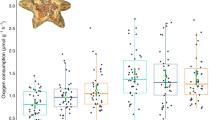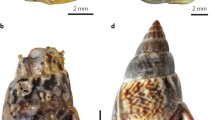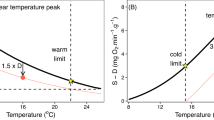Abstract
This study has demonstrated an interaction between the effect of increased ocean acidity and temperature (40 days exposure) on a number of key physiological parameters in the ophiuroid brittlestar, Ophiura ophiura. Metabolic upregulation is seen in the low pH treatments when combined with low temperature. However, this is far outweighed by the response to elevated temperature (+4.5°C). In the high temperature/low pH treatments treatments (where calcite is undersaturated) there appears to be an energetic trade-off likely in order to maintain net calcification where dissolution of calcium carbonate may occur. This energy deficit results in a ~30% reduction in the rate of arm regeneration at pH 7.3 which is predicted to be reached by the year 2300. This understanding of how O. ophiura responds to ocean acidification, taking into account an interactive effect of temperature, suggests that fitness and survival may indirectly be reduced through slower recovery from arm damage.







Similar content being viewed by others
References
Allee WC (1923) The effect of temperature in limiting the geographic range of invertebrates in the Woods Hole littoral. Ecology 4:341–354
Anderson MJ (2001) A new method for non-parametric multivariate analysis of variance. Aust Ecol 26:32–46
Anderson MJ, Gorley RN, Clarke KR (2008) PERMANOVA + for PRIMER: Guide to software and statistical methods. PRIMER-E, Plymouth, p 214
Bergman MJN, van Santbrink JW (2000) Fishing mortality of populations of megafauna in sandy sediments. In: Kaiser MJ, de Groot SJ (eds) The effects of fishing on non-target species and habitats. Biological conservation and socio-economic issues. Blackwell Science, Oxford, pp 49–68 399 pp
Bergman MJN, Ball B, Bijleveld C, Craeymeersch JA, Munday BW, Rumohr H, van Santbrink JW (1998) Direct mortality due to trawling. NIOZ-Rapport 1998-1, RIVO-DLO Report C003/98, pp 404. Netherlands Institute for Sea Research, Den Burg, Texel
Bibby R, Cleall-Harding P, Rundle S, Widdicombe S, Spicer J (2007) Ocean acidification disrupts induced defences in the intertidal gastropod Littorina littoria. Biol Lett 3:699–701
Bowmer T (1982) Reproduction in Amphiura filiformis (Echinodermata: Ophiuroidea): seasonality in gonad development. Mar Biol 69:281–290
Brett JR (1970) Fish: functional responses. In: Kinne O (ed) Marine ecology, vol 1 Environmental factors, Part 1, Chapter 3 Temperature. Wiley-Interscience, Chichester, pp 515–616
Caldeira K, Wickett ME (2003) Anthropogenic carbon and ocean pH. Nature 425:365
Christensen AB, Colacino JM (2000) Respiration in the burrowing brittlestar Hemipholis elongata Say (Echinodermata, Ophiuroidea): a study of the effects of environmental variables on oxygen uptake. Comp Biochem Physiol A 127:201–213
Dahm C (1993) Growth, production and ecological significance of Ophiura albida and O. ophiura (Echinodermata: Ophiuroidea) in the German Bight. Mar Biol 116:431–437
Dashfield SL, Somerfield PJ, Widdicombe S, Austen MC, Nimmo M (2008) Impacts of ocean acidification and burrowing urchins on within sediment pH profiles and subtidal nematode communities. J Exp Mar Biol Ecol 365:46–52
Dickson AG (1990) Standard potential of the reaction—AgCl(S) + 1/2H − 2(g) = AG(S) + HCL(aq) and the standard acidity constant of the ion HSO4—in synthetic sea-water from 273.15-K to 318.15-K. J Chem Thermodynam 22:113–127
Dickson AG, Millero FJ (1987) Comparison of the equilibrium-constants for the dissociation of carbonic-acid in seawater media. Deep Sea Res 34:1733–1743
Dupont S, Thorndyke MC (2006) Growth or differentiation? Adaptive regeneration in the brittlestar Amphiura filiformis. J Exp Biol 209:3873–3881
Dupont S, Havenhand J, Thorndyke W, Peck L, Thorndyke MC (2008) Near-future level of CO2-driven ocean acidification radically affect larval survival and development in the brittlestar Ophiothrix fragilis. Mar Ecol Prog Ser 373:285–294
Ellis JR, Rogers SI (2000) The distribution, relative abundance and diversity of echinoderms in the eastern English Channel, Bristol Channel, and Irish Sea. J Mar Biol Assoc UK 80:127–138
Fell HB (1966) The ecology of Ophiuroids. In: Boolootian RA (ed) Physiology of echinodermata. Interscience Publ., NY, pp 129–143
Findlay HS, Wood HL, Kendall MA, Spicer JI, Twitchett RC, Widdicombe S (2009) Calcification, a physiological process to be considered in the context of the whole organism. Biogeosci Disc 6:2267–2284
Gaston KJ, Chown SL, Calosi P et al (2009) Macrophysiology: a conceptual re-unification. Amer Nat 174:595–612
Gyhoot M, Cobb JLS, Thorndyke MC (1994) Localization of neuropeptides in the nervous-system of the brittle star Ophiura ophiura. Phil Trans Roy Soc Lond B 346:433–444
Hayward PJ, Ryland JS (1990) Handbook of the marine fauna of north-west Europe. Oxford University Press, Oxford, p 673
Huntsman AG, Sparkes MI (1925) Limiting factors for marine animals. 3. Relative resistance to high temperatures. Contrib Can Biol 2:97–113
Kinne O (1970) Invertebrates. Temperature effects. In: Kinne O (ed) Marine ecology, vol 1: Environmental factors, Part 1. Wiley-Interscience, Chichester, pp 407–514
Kurihara H, Shirayama Y (2004) Effects of increased atmospheric CO2 on sea urchin early development. Mar Ecol Prog Ser 274:161–169
McArdle BH, Anderson MJ (2001) Fitting multivariate models to community data: a comment on distance-based redundancy analysis. Ecology 82:290–297
McDonald MR, McClintock JB, Amsler CD, Rittschof D, Angus RA, Orihuela B, Lutostanski K (2009) Effect of ocean acidification over the life history of the barnacle Amphibalanus amphitrite. Mar Ecol Prog Ser 385:179–187
Mehrbach C, Culberson CH, Hawley JE, Pytkowicz RM (1973) Measurement of the apparent dissociation constants of carbonic acid in seawater at atmospheric pressure. Limnol Oceanogr 18:897–907
Metzger R, Sartoris FJ, Langenbuch M, Pőrtner HO (2007) Influence of elevated CO2 concentrations on thermal tolerance of the edible crab Cancer pagurus. J Therm Biol 32:144–151
Michaelidis B, Ouzounis C, Paleras A, Pörtner HO (2005) Effects of long-term moderate hypercapnia on acid-base balance and growth rate in marine mussels Mytilus galloprovincialis. Mar Ecol Prog Ser 293:109–118
Miles H, Widdicombe S, Spicer JI (2007) Effects of anthropogenic seawater acidification on acid-base balance in the sea urchin Psammechinus miliaris. Mar Poll Bull 54:89–96
Moore A, Cobb JLS (1985) Neurophysiological studies on the detection of amino acids by Ophiura ophiura. Comp Biochem Physiol 80A:229–308
Mortensen Th (1927) Handbook of the echinoderms of the British Isles. Oxford Univ Press, London, p 471
O’Connor B, Bowmer T, Grehan A (1983) Long term assessment of the population dynamics of Amphiura filiformis (Echinodermata: Ophiuroidea) in Galway Bay (west coast of Ireland). Mar Biol 75:279–286
Orr JC et al (2005) Anthropogenic ocean acidification over the twenty-first century and its impact on calcifying organisms. Nature 437:681–686
Parker LM, Ross PM, O’Connor WA (2009) The effect of ocean acidification and temperature on the fertilization and embryonic development of the Sydney rock oyster Saccostrea glomerata (Gould 1850). Global Change Biol 15:2123–2133
Pierrot DEL, Wallace DWR (2006) Co2sys Dos program developed for CO2 system calculations. ORNL/CDIAC-105. Carbon Dioxide Information Analysis Center, Oak Ridge National Laboratory, U.S. Department of Energy, Oak Ridge, Tennessee
Pörtner HO, Langenbuch M, Michaelidis B (2005) Synergistic effects of temperature extremes, hypoxia, and increases in CO2 on marine animals: from earth history to global change. J Geophys Res Oceans 110:C9
Shirayama Y, Thornton H (2005) Effect of increased atmospheric CO2 on shallow water marine benthos. J Geophys Res 110:C09S08
Somero GN (1997) Temperature relationships: from molecules to biogeography. In: Dantzler WH (ed) Handbook of physiology. Section 13 Comparative physiology, vol 2. Oxford University Press, Oxford, pp. 1391–1444
Somero GN, Dahlhoff E, Lin JJ (1996) Stenotherms and eurytherms: mechanisms establishing thermal optima and tolerance ranges. In: Johnston IA, Bennett AF (eds) Animals and temperature. Phenotypic and evolutionary adaptation. Cambridge University Press, Cambridge, pp 53–78
Spicer JI, Eriksson SP (2003) Does the development of respiratory regulation always accompany the transition from pelagic larvae to benthic fossorial postlarvae in the Norway lobster Nephrops norvegicus (L.)? J Exp Mar Biol Ecol 295:219–243
Stillman JH (2002) Causes and consequences of thermal tolerance limits in rocky intertidal porcelain crabs, genus Petrolisthes. Integr Compar Biol 42:790–796
Tyler PA (1977) Seasonal variation and ecology of gametogenesis in the genus Ophiura (Ophiuroidea: Echinodermata) from the Bristol Channel. J Exp Mar Biol Ecol 30:185–197
Valentincic T (1991) Behavioral responses of the brittle star Ophiura ophiura to chemical stimuli during adaptation of amino acid chemoreceptors. Chem Sens 16:267–275
Widdicombe S, Needham HR (2007) Impact of CO2-induced seawater acidification on the burrowing activity of Nereis virens and sediment nutrient flux. Mar Ecol Prog Ser 341:111–122
Widdicombe S, Spicer JI (2008) Predicting the impact of Ocean acidification on benthic biodiversity: what can physiology tell us? J Exp Mar Biol Ecol 366:187–197
Wood HL, Spicer JI, Widdicombe S (2008) Ocean acidification may increase calcification, but at a cost. Proc Roy Soc Lond B 275:1767–1773
Acknowledgments
The authors thank the crew of RV Sepia for assistance with animal collection, Lara Clark and Helen Findlay for their help in the laboratory and Paul Somerfield for statistical advice. In addition, we are grateful to Chris Hauton and the two anonymous reviewers for their useful comments and constructive criticisms on an earlier draft of this paper. This work contributes to the NERC funded program Oceans 2025 (Theme 3—Coastal and shelf processes). This work is also a contribution to the “European Project on Ocean Acidification” (EPOCA) which received funding from the European Community’s Seventh Framework Programme (FP7/2007-2013) under grant agreement n° 211384.
Author information
Authors and Affiliations
Corresponding author
Additional information
Communicated by U. Sommer.
Rights and permissions
About this article
Cite this article
Wood, H.L., Spicer, J.I., Lowe, D.M. et al. Interaction of ocean acidification and temperature; the high cost of survival in the brittlestar Ophiura ophiura . Mar Biol 157, 2001–2013 (2010). https://doi.org/10.1007/s00227-010-1469-6
Received:
Accepted:
Published:
Issue Date:
DOI: https://doi.org/10.1007/s00227-010-1469-6




